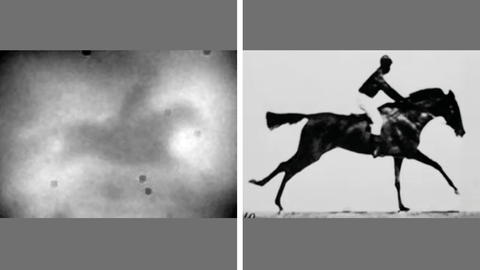Nov 11, 2025
Paving new ways in biomedicine: TUD researchers are combining less invasive diagnostics with quantum imaging and artificial intelligence

left: Image of a horse that was "beamed" using quantum entanglement, right: original image used for the quantum image.
Quantum technologies are a promising step towards major advances in high-performance computers, secure communication and also medical diagnostics. A team of researchers from TUD Dresden University of Technology and TU Darmstadt is now experimenting with the application of quantum imaging in biomedicine, e.g. in cancer diagnostics.
The researchers used entangled photons (light particles) to transfer the image of a horse to a camera. But here’s the special thing about it: the light particles that scanned the image were never measured with the camera. Instead, their entangled “partner” light particles were registered on the camera, which in turn never came into contact with the image of the horse.
Imaging with the help of quantum entanglement
In the experiment, the researchers made use of quantum entanglement, in which the state of two or more particles is inextricably linked, even if they are spatially separated from each other. Measuring one particle instantly influences the state of the other, which Albert Einstein described as a "spooky action at a distance."
The method opens up a totally new world of novel applications for biomedicine, which will also be researched at the Cluster of Excellence "Physics of Life" at TUD Dresden University of Technology. The basic assumption is that healthy tissue and tissue affected by cancer cells absorb light differently. The method could be used to examine tissue very gently with infrared radiation. However, the non-visible radiation would not have to be recorded with infrared cameras, as was previously the case. This is because the new research approach uses entangled photons to transfer image information from invisible light (such as infrared, terahertz or X-ray radiation) to visible light. The latter can be captured with a standard camera and is therefore easier to measure.
Development of new biomedical diagnostic methods
Diagnostic methods using visible radiation in combination with AI-based analyses — enabling cancer examinations through virtual staining without the use of chemical agents — are regarded as highly promising for the development of new biomedical diagnostic approaches that are significant for both fundamental research and clinical medicine.
The research results were recently presented at a conference: Juergen W. Czarske, L. Buettner, S. Krause, et al, Advancing computational imaging using physics-informed deep learning towards biomedicine, quantum technology and metaverse, Conference at Tsinghua University, Beijing, October 15, 2025
About the research project
The research project "3D quantum imaging with non-detected light and wavefront control" focuses on the development and application of quantum imaging techniques based on spatially correlated photons. In particular, new methods of examination for medical diagnostics are being developed that enable gentle 3D imaging and thus offer a promising alternative to conventional fluorescence labeling. The team includes Prof. Juergen Czarske, Dr. Lars Buettner and Dr. Stefan Krause from the "Biomedical Computational Laser Systems" (BIOLAS) competence center at TUD Dresden University of Technology, as well as Prof. Markus Graefe and Jonas Vasikonis from TU Darmstadt. The project is funded by the German Research Foundation (DFG).
Professor Jürgen Czarske has already received a grant of EUR 1.5M from the DFG's renowned Reinhart Koselleck Program for his fundamental research in the project "Physics-Informed Deep Learning Systems for Secure Information Transmission with Multimode Fibers" (Phys-Deep-Fiber).
About quantum entanglement
In quantum entanglement, photons have a common quantum state and are connected (or entangled) in such a way that they share the same properties, even over large distances. If the property of an entangled particle is measured, the corresponding property of the other particle is also revealed.
Prof. Prof. h. c. Dr.-Ing. habil. Juergen Czarske
Chair of Measurement and Sensor Systems
TUD Dresden University of Technology
+49 351 463-34803
